Understanding Essential SEO Metrics for Cybersecurity
When data breaches and cybersecurity threats dominate the headlines, simply having an online presence isn’t enough. Your cybersecurity business needs a strong, strategic SEO approach to generate consistent, high-quality leads. And not just any leads but qualified prospects driven by high-intent keywords, which are uncovered and leveraged through effective SEO for cybersecurity.
Cybersecurity SEO is the best way to do it because 63.41% of all US web traffic referrals come from Google. [1]
Don’t kid yourself – it’s not the same to rank for “What is cybersecurity” and “cybersecurity services”. While both of these keywords serve their purpose, the latter one will actually have a positive impact on your bank account.
But how can you improve your SEO rankings for these keywords that increase your revenue and get dozens of leads daily just from cybersecurity SEO?
If your cybersecurity firm isn’t ranking well, you’re not just invisible you’re exposed. Weak SEO indicates poor risk management and leaves you missing out on a high-intent audience actively searching for trusted solutions. If you’re not targeting the right keywords, you’re not investing, you’re wasting.
In this blog, we will teach you SEO practices and how to incorporate a digital marketing strategy for your cybersecurity business, providing professionals and businesses with the tools to get QUALIFIED leads and achieve higher search engine rankings in the field of cyber security.
SEO for Security Companies: Results You Can Expect
We like to start with an answer to the question you’re probably asking yourself now “What’s in it for me?”
That’s a valid concern, and because of that, we’re going to show you the actual numbers you can expect for the metrics that drive business results: revenue, cost, and profit in cybersecurity SEO.
To illustrate the effectiveness of the strategies we’re going to discuss in this blog, let’s examine a real-world case study of a cybersecurity firm that successfully implemented these SEO techniques to achieve significant SEO and client acquisition growth.
Case Study #1: From Zero to $1M: One Year SEO Success for a Cybersecurity Company
One of our favorite case studies is of one of our clients – a Cybersecurity company. They are in charge of protecting major enterprises of various industries from cyber crimes by offering penetration testing, dark web monitoring, cloud security, and supply chain protection.
The Challenge
Despite their competence and strong industry reputation, our client had nearly no online presence. No search rankings. No traffic. No leads. And they wanted to break into two very competitive markets, namely the US and the UAE.
In an industry where cybercrime costs trillions annually, an underground economy that has a bigger turnover than the economies of Japan and Germany combined, being invisible online was a tough position to be in.
Our Approach: Constructing an SEO Strategy
The plan was set. Our goal was to help the client build an online presence appropriate to their enterprise in their respective domain. The way to do that is by creating a solid SEO strategy, and this was our approach that worked:
1. Laying the SEO Foundation
We started with thorough keyword research using tools like Ahrefs that allowed us to map out search trends and find keywords with the appropriate balance of search volume, competition, and intent. We looked for keywords that those in a position of decision maker were searching, such as “penetration testing services,” “IT security firms in UAE,” and more.
2. Creating Content that Builds Authority
In a domain this sensitive, our goal wasn’t just ranking by stuffing in keywords. Real SEO involves building authority, so, we developed a content strategy that involved creating numerous pages for each service.
This way, when someone searches for “penetration testing services,” they land on a page specifically built to address that need. Along with that, we wrote 4-6 long-form articles monthly on cybersecurity trends and solutions.
3. Fixing Technical SEO Issues
Google is a big fan of fast and easy-to-navigate websites, and does not appreciate those that aren’t technically sound, to put it mildly. So, we performed a technical audit via Google Search Console and fixed indexing errors, speed issues, duplicate content, and broken links.
Then, we moved to making the website faster. We achieved that by enabling lazy loading, compressing images, and optimizing the servers. Since most people use their mobiles for search, and Google prioritizes mobile-first indexing, we also optimized for mobile and added schema markup to boost search visibility.
4. Building Authority Through Backlinks
Instead of focusing on sheer numbers, we focused on getting actual quality backlinks. We studied competitor backlink profiles to find what worked and what didn’t work for them, as well as flaws in their approach.
We then started creating guest posts as well as working on digital PRs. We were able to get our clients over 250 quality backlinks from well-respected sites, securing over 250 of those for our clients from top cybersecurity blogs, industry publications, tech websites, as well as niche directories and resource pages.
With so many high-quality backlinks from reputable websites, Google considered our client’s website an authority, which resulted in better rankings.
5. Strategic Local SEO for US and UAE Markets
Breaking into large and well-established markets is extremely difficult. So, we adopted the approach of hyper-focusing on high-intent local searches like “cybersecurity companies in Dubai” and “top cybersecurity firms in the US.” This helped our client dominate local search results in these competitive markets.
The Results: Massive Growth in Just One Year
The transformation was incredible for our client. They went from barely having any online visibility to ranking for 4,500 keywords, with 125 being on Google’s top three spots. Monthly website visitors shot up from 14 to over 5,300. That is a 38,000% increase.
Their domain rating jumped by 42 points thanks to 791 new high-quality backlinks and 254 new referring domains. And today, they’re a top name in cybersecurity searches in London, Dubai, and the US, and even AI search engines recognize their authority.
This online success resulted in real business growth, seven-figure revenue growth in just 12 months.
#2 Case Study
A leading cybersecurity firm approached us to help them drive more organic traffic to their website through an effective SEO strategy focused on search engine optimization techniques, including tailored SEO services that integrated cybersecurity marketing.
Despite offering top-tier cybersecurity services, they struggled with low website visibility in search engine results due to outdated search engine algorithms, limited organic traffic, and minimal SEO rankings, an issue that highlights the importance of cybersecurity marketing strategies for many companies amidst increasing cyber threats.
To address these challenges, we created an SEO strategy and implementation plan that covered all of the aspects of cybersecurity SEO we mentioned in this blog, such as:
Link Building
The biggest problem we encountered was the client’s low domain authority. Their competitors had a much stronger backlink portfolio, and because of that, we decided to resolve that issue by building six high-quality backlinks.
High-Quality Content Creation
We created four to six onsite articles, adding up to about 7,000 words every month, focusing on relevant cybersecurity topics, including the handling and protection of sensitive data and the prevention of malicious code, in addition to cyber threats, to attract and engage the target audience with high quality content, while ensuring robust website security measures. We also developed dedicated landing pages for the firm’s different services to target specific search queries and improve conversions, incorporating SEO for cybersecurity to enhance visibility while ensuring protection against malware threats.
Keyword Tracking and Monitoring
We also introduced a keyword tracking system to monitor rankings daily and optimized content based on real-life data and valuable insights.
Technical SEO
Strong content relies on a solid technical foundation. To address this, we took a proactive approach by conducting regular audits and resolving technical issues as they arose. By prioritizing fixes based on their impact, we were able to reduce technical barriers and improve overall search visibility and SEO performance.
Results

The number of organic traffic increased dramatically by 37,992.9%, from a low starting point to a substantial number, as shown in the screenshot above.
- Total clicks increased by 176.642%
- Impressions jumped by 44.8399%
- CTR doubled compared to the previous period
Over two years, the firm gained:
- 42 domain rating points
- 791 new backlinks
- 254 new referring domains

The number of keywords they ranked for increased by 150,000%, from just three keywords initially to 4,503 relevant keywords now. Plus, they now have 125 keywords ranking in the top three positions
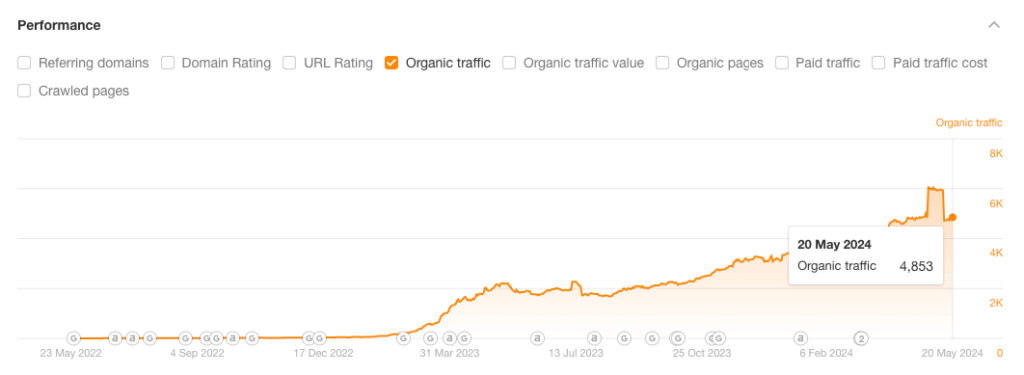
But not just any keywords! We spoke with them about their business goals, and their primary one was to dominate the market in UAE.
One of the most significant results toward that goal was ranking in first position for terms such as “cybersecurity companies in dubai,” “cybersecurity dubai,” “it security companies in dubai,” and “cybersecurity companies in uae”.
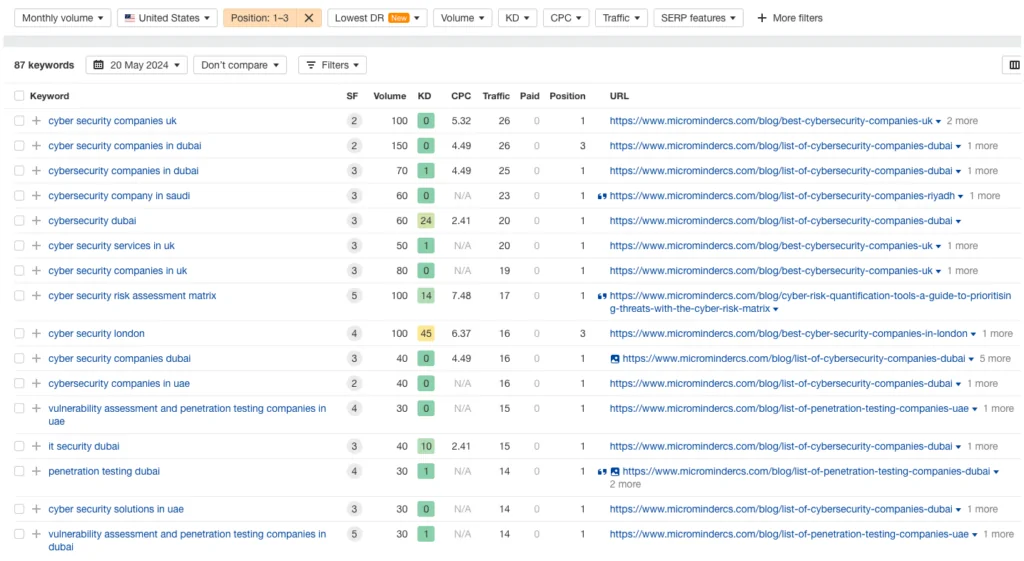
#3 Case Study
Another cybersecurity consulting firm that offers fixed-cost subscriptions for virtual Chief Information Security Officer (vCISO) services for startups wanted NUOPTIMA’s cybersecurity marketing expertise to increase their leads from SEO.
Cybersecurity SEO Results
- Achieved an 11.6x increase in organic traffic within six months.
- Secured 125 keywords on the first page of Google, significantly boosting visibility.
- Garnered 646K total impressions and 4.11K clicks, demonstrating the effectiveness of their SEO strategy.
But how did we achieve these results in 6 months?
We conducted thorough keyword research to identify high-value search terms relevant to their cyber security services and focused on long-tail and niche-specific terms to capture targeted traffic.
When we completed keyword research, it was time to develop high-quality, educational content via informative blog posts related to cybersecurity marketing. These blog posts positioned Eden Data as an authority in the field.
Of course, we also optimized every on-page element, such as meta tags, headers, and images. Aside from content, they also gained a significant boost in traffic with our link building services from authoritative websites.
So, do you want to go through a transformation from existing on the Internet to dominating the search results for money-making keywords?
We’ve got you!
Cybersecurity SEO: Top Strategies in 2025
Keyword Research for Cybersecurity
Keyword research for the cybersecurity industry is the first thing you need to cover if you want to generate leads from SEO.
To effectively attract potential clients – whether they’re looking for penetration testing, vulnerability assessments, incident response, secure website solutions, or other cybersecurity services – you need to target the right keywords.
The right keywords will help you rank higher on search engine results pages (SERPs) and attract the right audience – potential clients in need of cybersecurity solutions.
But how do you conduct effective to boost your SEO for cybersecurity-related terms?
Identify Your Target Audience
Start by understanding who your potential clients are. Are they small businesses, large enterprises, or individual consumers? Knowing your audience will help you choose the right keywords that resonate with their needs and search behaviors.
Use Keyword Research Tools
Tools like Google Keyword Planner, Ahrefs, SEMrush, and Moz, as well as web analytics platforms, will help you find relevant keywords by analyzing search results.
These tools can provide insights into search volume, keyword difficulty, and related keywords that you might not have considered.
When you combine insights from your audience and keyword research tools, you’re on a path that will guide you to long-term SEO success.
Let’s take a look at an example.
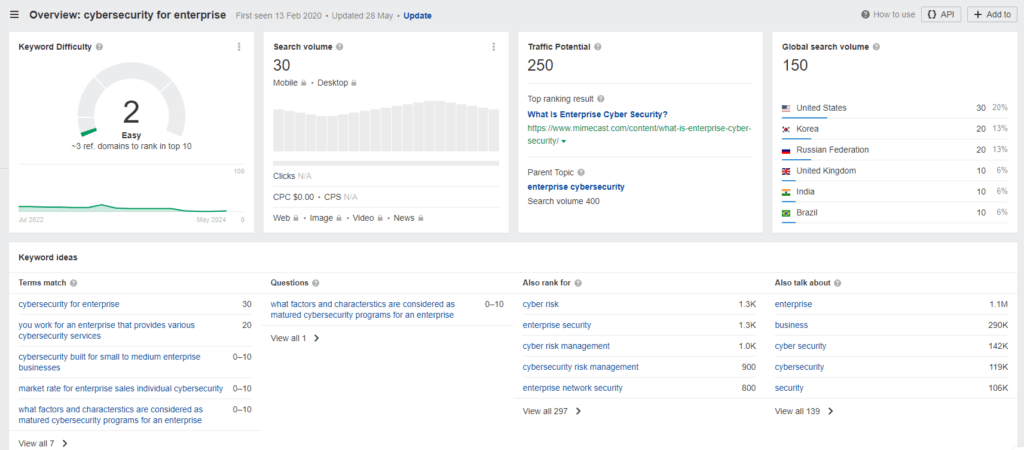
If your target audience are enterprise companies looking for cybersecurity services, you’ll target the keyword “cybersecurity for enterprise.” This is a fairly easy keyword to rank for, as it has only 2% keyword difficulty.
The search volume isn’t great, but bear in mind that those people searching for this keyword are the highly relevant audience who will, at worst, request a quote and, at best, become your enterprise clients.
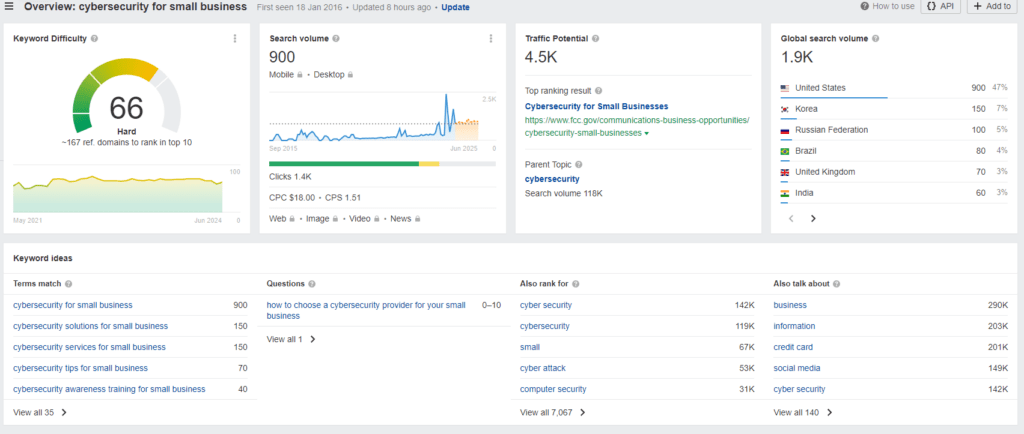
Plus, your content on that page needs to be highly optimized and better than competitors. When you cover it all, you’ll still have to gather more backlinks and optimize the page to keep improving your position in SERPs.
Focus on Long-Tail Keywords
Long-tail keywords are longer, more specific phrases that users are more likely to use when they’re closer to making a purchase or finding the information they need. Examples are “best cybersecurity solutions for small businesses” or “how to protect against ransomware attacks.”
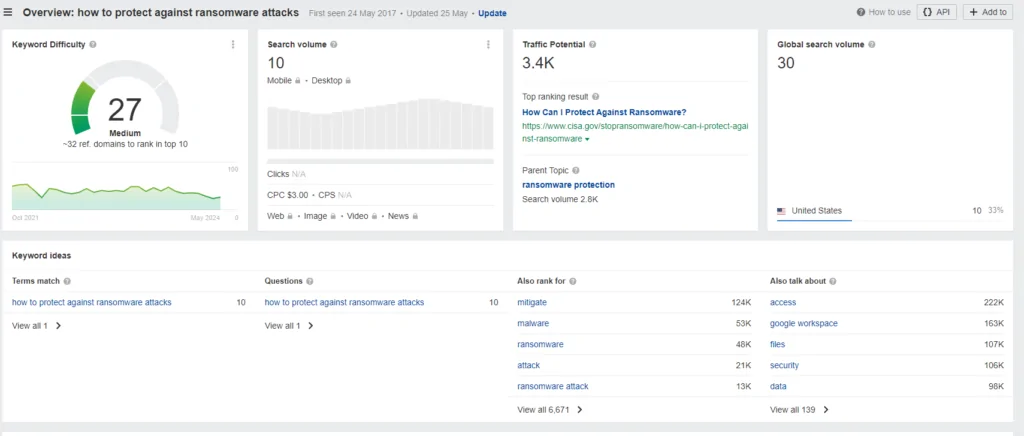
Analyze Competitor Keywords
Look at the keywords your competitors are targeting. Tools like Ahrefs and SEMrush can help you see which keywords are driving traffic to their sites, providing ideas for your own keyword strategy.
To analyze competitor keywords, for example, for CrowdStrike.com using Ahrefs, start by entering the CrowdStrike.com URL into Ahrefs’ Site Explorer tool.
Navigate to the “Organic Search” section to view the organic keywords that CrowdStrike ranks for. Examine the top-performing keywords in terms of search volume, keyword difficulty, and traffic potential, with a particular focus on those related to educational content in cybersecurity.
Pay attention to the keywords that are driving the most traffic to CrowdStrike’s site, especially those being targeted by other leading cyber security companies. Use the “Top Pages” report to identify which pages are performing best and the specific keywords they target.
You should also review the “Content Gap” tool to discover keywords that your site does not rank for but are bringing traffic to CrowdStrike. This analysis will help you identify valuable keywords to target, gaps in your own SEO for security companies, and opportunities to enhance your seo practices.
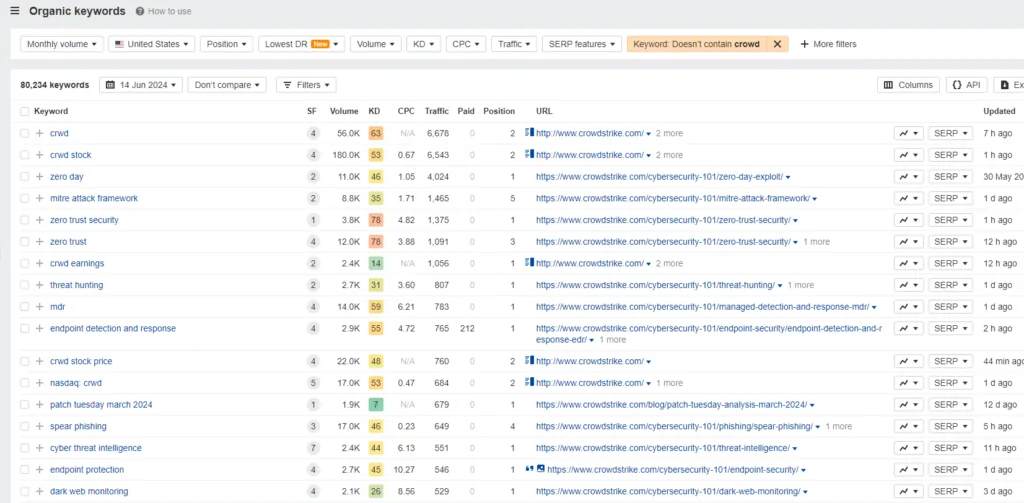
Incorporate Semantic Search Terms
Google’s algorithms are getting better at understanding user intent.
Use related terms and synonyms in your content to capture a wider range of search queries. For example, if you’re targeting “cybersecurity solutions,” also include terms like “online security,” “data protection,” and “network security.”
Consider User Intent
Understand the intent behind the keywords to derive valuable insights into the needs and preferences of your audience.
Are users looking for information, solutions, or specific products? Tailor your content to meet these needs.
For example, someone searching for “how to prevent phishing attacks” is likely looking for informative content, while someone searching for “cybersecurity services pricing” is probably closer to purchasing.
Jump on Trends
The world of cybersecurity is constantly changing, and effective cyber security risk management is crucial as new cyber threats, such as malware, and solutions emerge regularly. Regularly revisit and update your keyword list and publish content related to emerging trends to get website traffic.
The sooner you jump on trends, the better your chances of ranking!
SEO Content
Focus on E-E-A-T (Expertise, Experience, Authoritativeness, Trustworthiness).
Google places a high value on content that demonstrates expertise, experience, authoritativeness, and trust.
Create author pages on your website for cybersecurity professionals and experts. Have them review the content, ensure it’s backed by credible sources, and regularly update it to reflect the latest developments in cybersecurity.
Take, for instance, a service like cybersecurity audits. To effectively convey E-E-A-T, you’ll have to create detailed author pages for the experts who conduct these audits, highlighting their qualifications, certifications, and years of experience in the field.
Plus, all content related to cybersecurity audits has to be meticulously reviewed by these experts, supported by credible sources, and regularly updated to reflect the latest industry standards and practices.
To learn more, check out this video that explores key SEO tactics tailored specifically for IT and cybersecurity businesses, focusing on how to optimize content for industry-relevant keywords, improve search visibility, and drive traffic that converts.
Create Comprehensive, In-Depth Content
Long-form content that thoroughly covers cybersecurity topics will position your site as an authoritative source long-term. Over time, you should cover all the questions a user might have on a specific subject related to security.
Creating high-quality, optimized content with effective seo for cybersecurity will improve your search engine rankings and attract potential clients to your cybersecurity business.
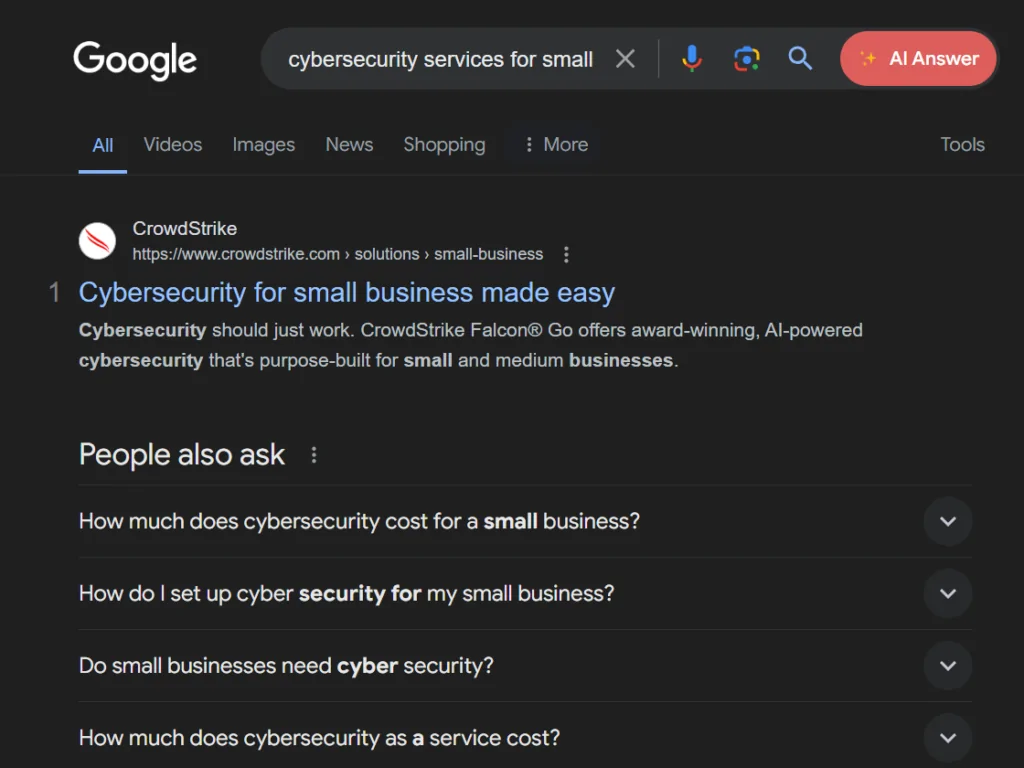
Develop a Content Strategy
Start by outlining a comprehensive content strategy that aligns with your business goals, integrates a robust SEO strategy, and leverages cybersecurity marketing to capture your target audience’s interest. Identify the topics that are most relevant to your audience and plan a content calendar for consistent publishing.
When creating your SEO content strategy for your cybersecurity website, you need to cover all of these aspects:
- Goals
- Audience pain points
- Topic research
- Topic formats
- Content calendar
- Metrics to measure success
Always plan for a mix of content types, such as blog posts, videos, and infographics and define success metrics based on where you currently stand.
For example, if you’re just starting out with Cybersecurity SEO, establishing a solid cybersecurity marketing strategy and tracking traffic as a performance indicator is essential. Later on, measure the conversions and lead generation of your SEO efforts.
Create Informative and Engaging Content
Your content should provide valuable information that addresses the needs and concerns of your audience, ultimately aiming for higher search engine rankings and improved seo rankings by delivering high quality content. Write detailed guides, how-to articles, and case studies that showcase your expertise in cybersecurity.
While cybersecurity is a serious topic, you should still use a conversational tone while ensuring maximum readability and fluency. In case of any hurdle, ask the paraphraser tool to refine content quality in an engaging way while also adjusting the tone. Besides this, incorporate storytelling, and break up text with headings, bullet points, and visuals.
Incorporate Target Keywords Naturally
The most important advice we can give you is to avoid keyword stuffing; instead, use keywords naturally within the context of your articles. Focus on including keywords in the title, headings, meta descriptions, and throughout the body text.
You don’t have to always use the exact match keywords; use synonyms and related terms to avoid repetition and improve content readability.
Use Compelling Headlines and Meta-Descriptions
Your headlines should grab attention and clearly convey the topic of your content.
Meta descriptions should be concise and include your primary keywords, encouraging users to click on your link in the search results. But how do you achieve this?
- Use power words, numbers, and questions to make your headlines compelling.
- Test different headlines and meta descriptions to see which ones perform better in terms of click-through rates. Monitor the change in search results to check CTR before and after the test in Google Search Console.
Include Visual Content
Improve your articles with relevant images, infographics, and videos. Visual content not only makes your articles more engaging but also helps break up text and improves readability.
- Use high-quality images that complement your content.
- Design infographics to visually represent data and complex information.
- Use descriptive alt text for images to improve accessibility and SEO.
- Include videos to increase engagement and provide additional value to your audience.
For instance, when explaining cybersecurity services such as network penetration testing or data encryption, a well-designed infographic can make complex information, including the protection of sensitive data, more accessible and easier to understand for your audience.
High-quality images that complement your content can further illustrate key points, while videos can provide in-depth demonstrations or case studies, increasing engagement and offering additional value.
Use Market-Specific Expansion Tactics
There is SEO, and then there is local SEO. If a business plans to expand into an international market, a generic SEO strategy will fall short. The key is to utilize local SEO.
For example, if the goal is to enter the UAE market, targeting high-intent keywords such as “cybersecurity companies in Dubai” or “IT security firms in UAE” can connect a brand directly with decision-makers looking for specific services. The same logic applies to the USA or any other country.
To get the best results from this approach, it must be combined with region-specific landing pages and content that reflect local terminology, challenges, and priorities. Instead of trying to rank for broad global keywords, the focus should shift towards becoming the most visible and relevant option within each target location.
Implement Internal Links
Use internal links to guide users to other relevant content on your site, keeping them engaged for longer periods.
Longer engagement = better rankings in SERPs.
- Use descriptive and relevant anchor text for internal links. In the best-case scenario, you should use the primary keyword of the target page.
Update and Repurpose Content
Update your existing content regularly to keep it current and relevant, which can contribute to improved search rankings and better SEO performance. More specifically, repurpose your content in different formats, such as turning a blog post into a YouTube video or an infographic, to meet the different preferences of your target audience.
Measure and Analyze Performance
Use web analytics tools like Google Analytics and Google Search Console to track the performance of your content. Monitor metrics such as page views, queries, engagement rates, average time on page, and seo performance to understand what’s working and where there’s room for improvement.
Technical SEO
Technical SEO is the foundation of any successful SEO strategy. It ensures that your website is a secure website, easily crawlable, fast, and user-friendly.
For cybersecurity companies, a well-optimized site is crucial to build trust and authority in the eyes of both search engines and potential clients, while also ensuring robust website security. Balancing technical SEO vs content SEO is essential for a holistic approach to improving your search engine rankings and user experience.
A potential client is unlikely to trust your cybersecurity firm if it doesn’t prioritize its own website’s security and performance, especially at a time where cyber threats are increasingly sophisticated. Imagine potential clients visiting your cybersecurity website, only to encounter slow load times, no HTTPS, or a missing SSL certificate. These issues don’t just affect user experience—they raise doubts about your ability to safeguard digital assets, including your own.
But is that all there is about technical SEO and what other things do you need to keep in mind? Here are the key strategies for technical SEO to focus on:
Indexability
There is no point in publishing content that Google won’t crawl or index. That’s why indexability is the first step for technical SEO.
Start by submitting an XML sitemap to Google Search Console.
This sitemap helps search engines understand your site structure and find all your pages. You can generate a sitemap using tools like Yoast SEO for WordPress or Screaming Frog. Once created, log in to Google Search Console, navigate to “Sitemaps” under the “Index” section, and submit your sitemap URL.
Pro tip: Check your robots.txt file, usually located at yoursite.com/robots.txt, to ensure it isn’t blocking important pages. This file directs search engines on which parts of your site they can and cannot access, so make sure critical pages are not disallowed.
Site Speed
Site speed is important because it directly impacts user experience and search engine rankings.
Compressing images is a straightforward way to quickly improve load times. For example, if your website has large images that slow down loading times, compressing them can significantly boost speed.
Your images should be under 100kb and in WebP format because it preserves the quality better than PNG and JPEG formats. WebP Express plugin for WordPress can automatically convert all of your images to WebP.
Another important aspect is browser caching, which stores static files on visitors’ browsers and speeds up subsequent visits, thereby enhancing overall website security by reducing server load. You can install W3 Total Cache or WP Rocket on WordPress sites to handle this efficiently.
Descriptive and Clean URLs
Use short, keyword-rich URLs that clearly describe the content of the page.
Imagine a potential client landing on your cybersecurity firm’s website and seeing a URL like yoursite.com/page?id=123. It’s vague, uninformative, and can raise questions about your credibility—especially in an industry where trust and transparency are critical.
In cybersecurity, even seemingly small details like URL structure can influence how prospects perceive your expertise in handling threats like malware and maintaining a secure digital presence.
Avoid dynamic URLs with unnecessary parameters by using URL rewriting techniques like access for Apache servers or URL routing in your CMS.
Core Web Vitals
Use Google PageSpeed Insights to identify elements affecting LCP and implement the recommended optimizations.
Enhance First Input Delay (FID) by minimizing JavaScript execution during the initial page load. Specify size attributes for images and ads to minimize cumulative layout shift (CLS) and prevent unexpected layout shifts.
For example, if your website experiences layout shifts when images load, setting explicit width and height attributes can stabilize the page layout.
But don’t worry, as your SEO strategy, including technical SEO, SEO services, and search engine optimization, isn’t that complicated when the expert team handles your technical and educational content, helping you improve SEO rankings efficiently. Take your mind off it, and let us handle all the aspects of your cybersecurity website’s SEO and cybersecurity marketing while safeguarding against potential cyber threats. Remember, you’re just one call away from dominating search results in the cybersecurity industry.
Link Building
Link building supports your content efforts when your target keywords are highly competitive.
Create Link-Worthy Content
The foundation of successful off-page SEO services is content that others want to link to.
Creating and promoting original research is one of the best ways to attract backlinks.
But how do you do it?
Conduct original research and publish the findings on your website to provide valuable insights into industry trends and practices, which can be particularly effective for cybersecurity marketing. Research-based content is highly valuable and attracts backlinks from other websites citing your data. For example, a detailed report on the state of cybersecurity in 2025, backed by original research and data, is a valuable resource for other websites looking to reference credible information.
Monitor Competitor Backlinks
Monitoring competitor backlinks using tools like Ahrefs, SEMrush, or Moz can uncover opportunities for your own link building efforts. Analyze the backlink profiles of your competitors to identify the sources of their backlinks and explore opportunities to earn similar links for your site.
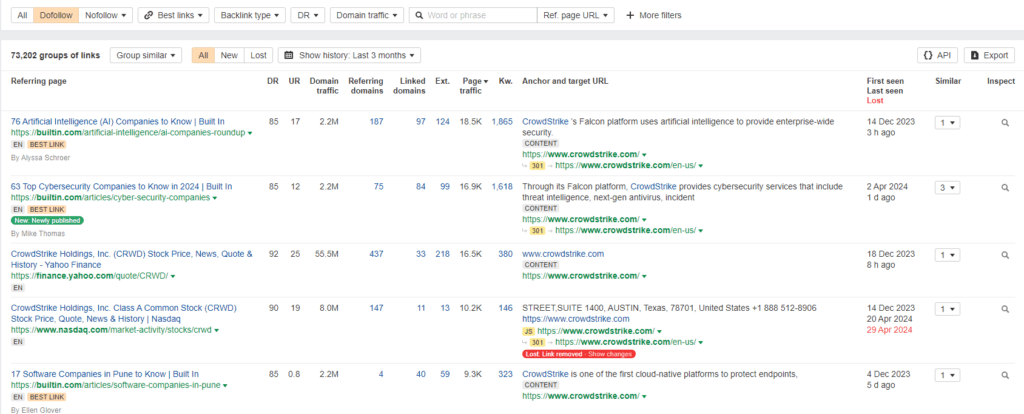
For example, if a competitor has a backlink from an industry blog, consider reaching out to that blog with a unique content pitch to earn a backlink as well.
Local SEO
If you provide services in specific areas, local SEO is your best friend.
Optimizing for local search will help you attract clients in your vicinity, build local authority, and drive more targeted traffic to your website. For businesses looking to streamline this process, white label local SEO services can be an excellent option, allowing for professional optimization without the need for in-house expertise.
Google Business Profile
Claiming and optimizing your Google Business Profile is the first step in local SEO efforts.
- Make sure your profile is accurate and complete.
- Include essential information such as your business name, address, phone number, website, and business hours.
- Select relevant categories that accurately represent your services.
- Regularly update your profile with new posts, photos, and offers.
Always choose relevant categories that precisely represent the services you offer, whether it’s network security, data protection, or cybersecurity consulting. For example, if your cybersecurity firm launches a new service, create a post on your GBP profile to inform potential customers.
Customer Reviews
Positive customer reviews and activity will promote your profile and make it appear often in search engine results.
- Encourage satisfied clients to leave reviews by sending follow-up emails or directly linking to your GBP review page.
- Respond promptly to reviews to show that you value customer feedback.
Create Location-Specific Pages
If your cybersecurity firm serves multiple locations, create dedicated landing pages for each area. Each page should include unique content tailored to the specific location, with local keywords and information relevant to clients in that area.
For example, if you provide cybersecurity services in New York, use phrases like “cybersecurity services in Boston” or “Boston cybersecurity solutions.”
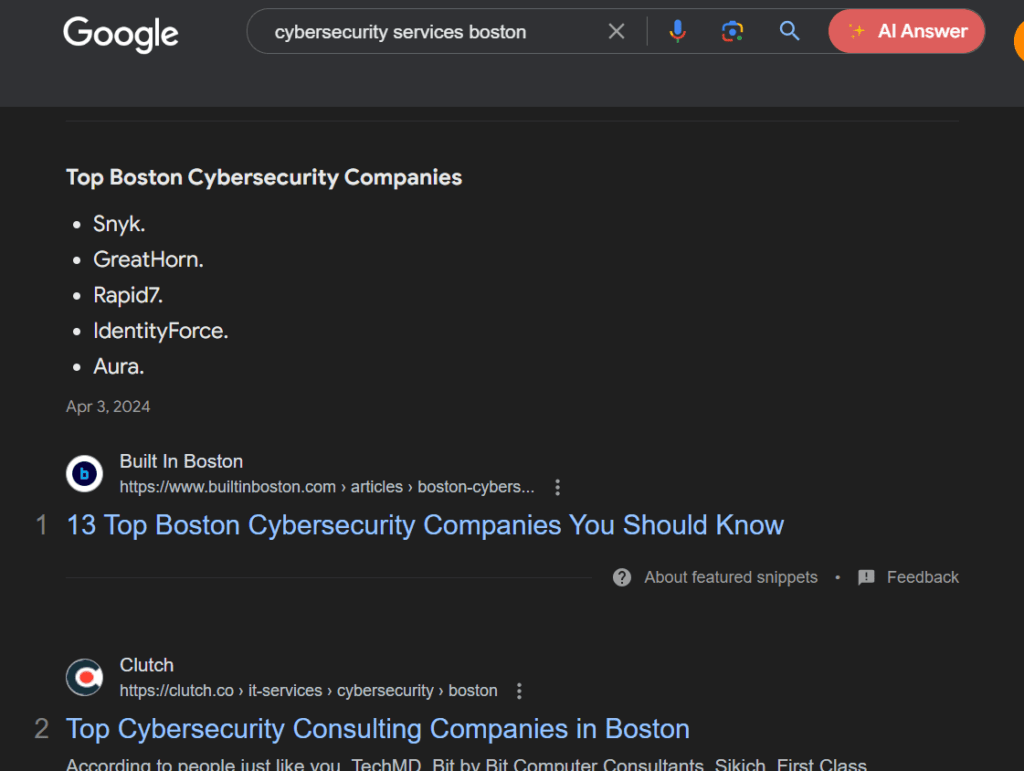
One of the best ways to boost your ranking on these pages is to implement local schema markup.
For local cybersecurity companies, the most relevant schema type is “LocalBusiness.” Depending on the specific details of your business, you might also consider “ProfessionalService” or “ITService” schemas.
Prepare the following information about your business for each location-specific landing page:
- Business name
- Address (including street address, city, state, and ZIP code)
- Phone number
- Website URL
- Business hours
- Description of services
- Geo-coordinates (latitude and longitude)
- Logo URL
- Social media profiles (if applicable)
Now, use the gathered information to create your schema markup with Schema Markup Generator tools.
Once you’re done, insert the JSON-LD script into the HTML of your location-specific landing pages. Place the script within the section or at the end of the section of your HTML document.
When you publish the pages, use Google’s Structured Data Testing Tool or the Rich Results Test to validate your schema markup. Enter the URL of your landing page or paste the markup code to check for errors and ensure everything is implemented correctly.
Conclusion
The case studies of Microminders and Eden Data show just how effective the right SEO strategies can be, driving significant growth in organic traffic, boosting keyword rankings, and strengthening domain authority.
But executing these strategies across keyword research, content creation, technical SEO, link building, local visibility, and risk management takes more than just know-how, it demands time, consistency, and the ability to stay ahead of ever-changing search algorithms.
If you’re serious about turning SEO into a real growth driver for your firm, it’s time to bring in a team that lives and breathes it.
That’s why we have a proposal for you. One you can’t refuse! But first, read how to choose an SEO agency. We want you to be as informed as possible when you decide to hire our expert SEO services.
Because these services will quickly get you results like we achieved for Microminders and Eden Data. How can we claim this?
Because we stay proactive, keep up with the latest SEO trends, and make sure your website reflects expertise, authority, and trustworthiness in all aspects – from keyword research, content, link building, and technical SEO to essential SEO practices.
When you book a call with us, we’ll tell you exactly where you stand with a free on-call audit of your current performance, analyze your search results, and propose a strategy that will get you where you want to be in terms of cybersecurity SEO and organic leads. e you want to be in terms of cybersecurity SEO and organic leads.
FAQ
SEO in the cybersecurity space requires more than just keywords — it’s about building trust, authority, and technical precision. Given the sensitive nature of the industry, your content, technical setup, and backlink profile must reflect credibility and expertise to attract high-intent clients.
Metrics that tie directly to business outcomes are key — organic traffic, keyword rankings (especially for service-related terms), conversion rate from SEO traffic, backlink quality, and domain authority. These reflect your online visibility and how well you’re turning that into qualified leads.
Because not all traffic converts. Ranking for “what is cybersecurity” may drive visitors, but terms like “cybersecurity services in Dubai” or “vCISO for startups” are used by people actively searching for help — the kind of traffic that brings in revenue.
While timelines vary, most firms start seeing noticeable improvements in keyword rankings and traffic within 3–6 months. Full lead generation potential and top-ranking positions often take 6–12 months, especially in competitive regions or verticals.
Neglecting technical SEO, failing to create service-specific landing pages, using broad non-converting keywords, ignoring backlinks, and underestimating the importance of E-E-A-T (expertise, experience, authority, and trust) in content creation.
If your firm serves specific regions, local SEO ensures you’re found by nearby clients searching for services. This includes optimizing your Google Business Profile, creating location-specific landing pages, and using local schema to boost visibility in regional search results.



